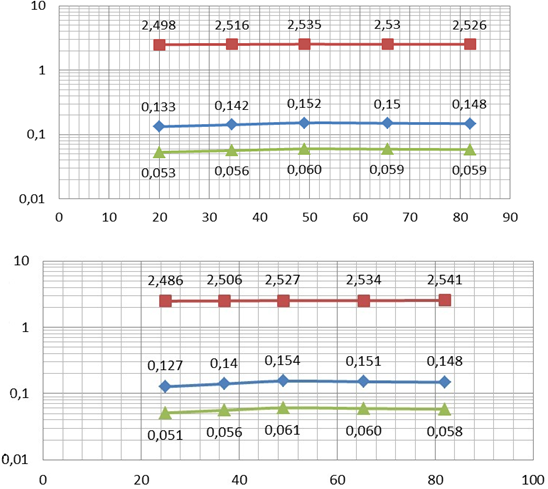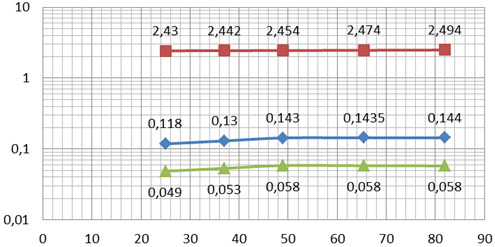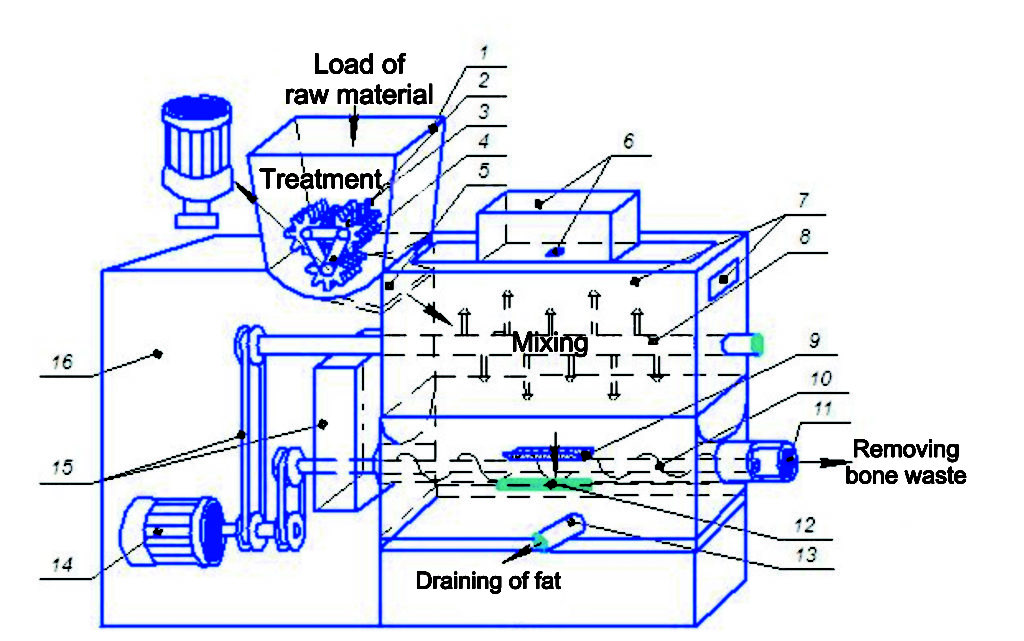ТЕРМООБРАБОТКА ЖИРОСОДЕРЖАЩЕГО СЫРЬЯ С ИСПОЛЬЗОВАНИЕМ ЭНЕРГИИ ЭЛЕКТРОМАГНИТНЫХ ИЗЛУЧЕНИЙ
Ершова И. Г.1, Белова М. В.2, Поручиков Д. В.3, Ершов М. А.4
1ORCID: 0000-0003-1126-3837, Кандидат технических наук, Чувашский государственный педагогический университет им. И.Я. Яковлева,2Кандидат технических наук, Казанский государственный аграрный университет, 3Чувашская государственная сельскохозяйственная академия, 4ORCID: 0000-0001-6439-3112, Кандидат химических наук, Чувашский государственный педагогический университет им. И.Я. Яковлева
ТЕРМООБРАБОТКА ЖИРОСОДЕРЖАЩЕГО СЫРЬЯ С ИСПОЛЬЗОВАНИЕМ ЭНЕРГИИ ЭЛЕКТРОМАГНИТНЫХ ИЗЛУЧЕНИЙ
Аннотация
В статье рассмотрено - совершенствование методики согласования конструкционно-технологических параметров установки с режимами ее работы с учетом конструктивных особенностей резонатора и изменения диэлектрических параметров сырья в процессе термообработки, рассмотрены способы и сверхвысокочастотные установки для термообработки жиросодержащего сырья, обладающие технической новизной.
Ключевые слова: электромагнитное поле сверхвысокой частоты, энергия электромагнитных излучений, термообработка, жиросодержащее сырье.Ershova I. G.1, Belova M. V.2, Poruchikov D. V.3, Ershov М. А.4
1ORCID: 0000-0003-1126-3837, PhD in Engineering, Chuvash I. Yakovlev State Pedagogical University, 2PhD in Engineering, Kazan State Agricultural University, 3Chuvash State Agricultural University, 4PhD in Chemistry, Chuvash I. Yakovlev State Pedagogical University
HEAT TREATMENT OF FAT-CONTAINING RAW MATERIALS WITH ENERGY OF ELECTROMAGNETIC RADIATION
Abstract
The article consideres improving matching techniques constructional and technological parameters of the installation with the modes of its work, taking into account the structural features of the resonator and the changes in the dielectric parameters of raw material during the heat treatment, presents methods and microwave units for heat treating fat-containing raw materials that have a technical novelty
Keywords: electromagnetic field of ultrahigh frequency, energy of electromagnetic radiation, heat treatment, fat-containing raw materials.It is known that the fat-containing feedstock processes are associated with the consumption of large amounts of electricity, steam and water. Heat treatment of raw materials is used for fat-melting. To remove the fat from the fat-containing tissue, it is necessary to destroy transfer the protein structure, comprising fat, transfer it from the intracellular to the extracellular phase, the free phase, and then remove the external environment. Currently, for this purpose the heat treatment received is widely used. To do this, it is used the convective or conductive heat supply method in direct contact with raw material steam or heat is applied to the raw materials through the wall of the coolant. Food fats and edible raw bone is treated to melting out of fat at a temperature of 90оС (gentle feedstock) and do100оС (bone). Duration of the heat treatment of raw materials is determined by the duration of exposure for melting and destruction of pathogenic microorganisms [1].
The aim of this work is to intensify the process of melting out the fat under the influence of the electromagnetic field of ultrahigh frequency on fat-containing raw materials while maintaining product quality.
To substantiate the structural and technological parameters and regimes of the plant for the heat treatment of raw material fat its physical, mechanical and dielectric properties were analyzed. Energy for denaturation of the protein by changing its temperature by 1 ° C for meat proteins during cooking is 0,84…1,26 kJ / (kg · K). Specific heat to melt fat is (1,3…3)·103 J / (kg · K), after melting 2,6·103 J / (kg · K).
Latent heat of melting fat (121…151)103 J / kg, the heat of evaporation of water (2480 – 2,27 ·Т)103 J / kg, where T - temperature of water evaporation оС.
Heat transfer coefficients during condensation of live steam is 840 ... 2780 W / (m2 · K), and by heating the water – 840///33300 W / (m2·K), the lowest ratios in the heating raw material air (85 W / (m2·K).
Table 1 - Humidity Body Fat tissues of animals
| The species of animal | Humidity,% | Density, kg/m3 |
| pork | 0,25 | 915…961 |
| chickens | 9,1 | 900 |
| cattle | 0,2 | 915 |
Acid number of fat - not more than 1,2...3,5. The melting point of tallow 42...52 º C, mutton 46...55 ºC, pork 28...46 ºC. Refractive index of animal fats at 40 º C is equal to 1,456 ... 1,460.
It is known that the specific heat ( J / kg ) required to process the fat-containing feedstock is the initial heating, melting fat , protein denaturation , and the final moisture evaporation heat , but it does not depend on the method of supplying energy [1]. A length to achieve the required temperature is determined by the type of raw weight of the energy supply , the intensity of heat and mass transfer , the ratio of volume, surface area and size of the raw material and its physical parameters. To intensify the heat we can raise the temperature of the medium , changing the conditions of heat , increasing the heat transfer surface at a constant weight of raw materials. Increased ambient temperature above 120...130 °C in the processing of raw material leads to a fat deterioration of melted fat. When grinding increased the heat transfer surface, is which intensifies the heat, accelerating the internal heat transfer of heat conductivity. In formulating the bone meal particles have a size of 25...35 mm.
Existing apparatus for melting out of fat running in periodic mode with a large volume, so the duration of the heat treatment process is 4...5 hours, which impairs the quality of fat and feed products. In view of these shortcomings and recommendations we propose to intensify the process of heat extraction of fat of good quality exposure to electromagnetic energy field of ultrahigh frequency shredded fat-containing raw materials.
We analyzed the dielectric characteristics raw material in a wide frequency range of the electromagnetic field, depending on temperature, moisture, fat (Fig. 1). High dielectric constant at low frequencies and a sharp drop in its frequency increases due to the relaxation process of charging and discharging at the cell membrane. In the microwave range (433, 915 and 2400 MHz) dielectric properties of foods were studied by Rogov A.M. The main factors influencing the dielectric properties of raw material are humidity, temperature, which should be considered when choosing of heat treatment mode. With decreasing humidity permittivity is reduced continuously. In the temperature range from 20 to 45 оС absorption coefficient increases due to the redistribution of moisture. Intracellular fluid as a result of diffusion processes can penetrate freely through the cell walls and change the fluid levels in the capillaries formed by muscle cells and intercellular spaces. All these features should be taken into account when justifying the penetration depth of the electromagnetic field of ultrahigh frequency in the feed to obtain a uniform distribution of the temperature of heating the entire volume.


Fig. 1 - Dielectric parameters of raw material fat: a) bacon, b) internal pork fat, c) pork lard
Installation designed for heat treating a fat raw material consists of four main modules. The first module provides a fat-containing raw material grinding by roller crusher. The second module is used for the heat treatment raw material in the resonator chamber due to the energy of the electromagnetic field of the microwave. The third module allows you to filter melted fat and forming bone waste through the discharge auger and matrix. The fourth module combines electric motors and Gear Units.
By ingestion raw material occurs between the rollers grinding raw materials and moving into a resonator chamber, where the endogenous heating of the crushed material. Take place in addition, for uniform heating throughout the volume of raw material beforehand include agitating auger and discharge mechanism. Heated to the melting temperature of the fat the raw material is adjudged in discharge auger. Next, extruded through a die bone waste, and melted fat is dripping through the filter into the receptacle. The resonator chamber is located in the screening housing. The plant operates in a continuous mode, providing parallel size reduction fat-containing raw material, its heat, the sweat fat injection molding and bone waste. Screws and screw discharge matrix allow further grind waste in the form of bone and bone meal with adjustable size grains. Structural features of the developed installation permit processes grinding of fat- raw materials and the melting out fat due to dielectric heating, split into two fractions, such as bone meal and melted fat. The quality of finished product depends on the combined action of two factors: the temperature of the endogenous heat and exposure dose of electromagnetic field of ultra-high frequency [4].

Fig. 2 - Installation of heat-treating the fat-containing raw materials: 1 - loading capacity; 2 - roller grinding mechanism; 3 - Stars set with motor; 4 - electric motor with a gear; 5 – Tray; 6 - microwave generator; 7 - the resonator chamber; 8 - Stir drive mechanism; 9 - box housing the discharge auger; 10 - discharge auger 11 – matrix; 12 – filter; 13 - feeding capacity; 14 – motor; 15 - belt drive and gear unit; 16 - shield casing
References
- Ivashov, V.I. Technological equipment of the meat industry. Part 1. Equipment for slaughter and processing. - Moscow: Kolos, 2001. – P. 552.
- Ershova, I. G. Technology of fat-containing raw materials / I. G. Ershova, M. G. Sorokina, O. V. Mihailova // Chuvash State Pedagogical University I.J. Yakovlev. – Cheboksary : CSPU, 2013. - № 4 (80). - P.34...37.
- Ershova, I. G. Installation for recycling fat-raw material with microwave energy / I. G. Ershova, M. G. Sorokina, M. V. Belova, G. V. Novikova // Izvestia Orenburg GAU, 2014. - № 1 (45). - P.54 ... 56.
- Ershova, I. G. Installation for heat treating fat-raw material in the ultrahigh frequency electromagnetic field / I. G. Ershova, G. V. Novikova, M. V. Belova, O. V. Michailova, M. G. Sorokina Natural and Technical Sciences, 2015. - № 1 (79). - P.129 ... 130.
